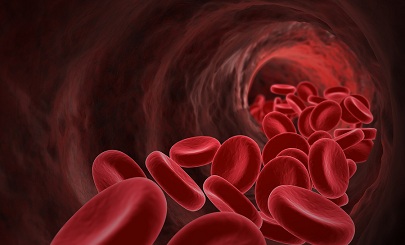COVID-19 Clinical Care: University of Michigan Study Discovers That Sub-Group Of COVID-19 Patients Exhibits High Bleeding Risk!
Source: COVID-19 Clinical Care Feb 02, 2021 4 years, 11 months, 1 week, 4 days, 1 hour, 44 minutes ago
COVID-19 Clinical Care: A new study by researchers from the Department of Internal Medicine, University of Michigan, Ann Arbor-USA has discovered that a sub-group of COVID-19 patients exhibit high bleeding risk contradicting an initial advocated protocol of administering high dose anticoagulants throughout the duration of their disease course.

From the study abstract, “
Typically patients with COVID-19 are at high risk for thrombotic arterial and venous occlusions. However, bleeding complications have also been observed in some patients. Understanding the balance between coagulation and fibrinolysis will help inform optimal approaches to thrombosis prophylaxis and potential utility of fibrinolytic-targeted therapies. 118 hospitalized COVID-19 patients and 30 healthy controls were included in the study. The study team measured plasma antigen levels of tissue-type plasminogen activator (tPA) and plasminogen activator inhibitor-1 (PAI-1) and performed spontaneous clot-lysis assays. The team found markedly elevated tPA and PAI-1 levels in patients hospitalized with COVID-19. Both factors demonstrated strong correlations with neutrophil counts and markers of neutrophil activation. High levels of tPA and PAI-1 were associated with worse respiratory status. High levels of tPA, in particular, were strongly correlated with mortality and a significant enhancement in spontaneous ex vivo clot-lysis. While both tPA and PAI-1 are elevated among COVID-19 patients, extremely high levels of tPA enhance spontaneous fibrinolysis and are significantly associated with mortality in some patients. These data indicate that fibrinolytic homeostasis in COVID-19 is complex with a subset of patients expressing a balance of factors that may favor fibrinolysis. Further study of tPA as a biomarker is warranted.”
The study findings were published in the peer reviewed journal: Scientific Reports.
https://www.nature.com/articles/s41598-020-80010-z
In any particular time, the human body strives to keep itself in homeostasis, or balance. When blood clots are created, the body's innate response is to break the clots down to prevent significant health problems from arising.
Past studies have found that patients with COVID-19 are prone to serious blood clotting. This is why in current
COVID-19 Clinical Care recommendations; many patients receive high dose anticoagulants as part of their treatment.
However a this new study led by senior author Dr Daniel Lawrence, Ph.D., a Professor of Basic Research in Cardiovascular Medicine at Michigan Medicine, found that aside from this heightened clotting risk, some COVID-19 patients have an unbalanced ability to break down clots as well, which is linked to a potential clinical biomarker seen in later stages of the disease.
Importantly this abnormal process of breaking down clots can contribute to a high bleeding risk, raising concerns about the current practice of giving COVID-19 patients high dose anticoagulants throughout the duration of their disease course.
The study findings may be consistent with the U.S. NIH's recent decision to pause enrollment of critically ill COVID-19 patients in the Antithromb
otic Therapy to Ameliorate Complications of COVID-19 (ATTACC) trial, because "a potential for harm in this sub-group could not be excluded."
Dr Yu (Ray) Zuo, M.D., M.S.C.S., first author and a rheumatologist at Michigan Medicine-University of Michigan told Thailand Medical News, “Pathological blood clotting in COVID-19 patients has been studied extensively, but recognizing and addressing the high bleeding risk in a subgroup of patients is equally important."
Dr Zuo, Dr Lawrence and their colleagues sought to understand the balance between COVID-19 coagulation and the breakdown of clots to help inform approaches to treatment.
The research included 118 COVID-19 patients and 30 healthy controls. In the COVID-19 patients, the team expected to see high levels of plasminogen activator-inhibitor-1, a molecule associated with stabilizing blood clots.
Surprisingly however, they did not expect high levels of tissue-type plasminogen activator, the molecule responsible for removing the clots.
Almost half of the study's patients were supported by a ventilator and a quarter breathed just room air according to the researchers.
Interestingly compared with the patients breathing room air, patients that required supplemental oxygen had significantly higher levels of plasminogen activator-inhibitor-1, but not of tissue-type plasminogen activator.
It must be noted that high levels of both tissue-type plasminogen activator (tPA) and plasminogen activator-inhibitor-1 (PAI-1) were associated with worse lung function, but high tPA independently correlated with mortality. The levels of either molecule can increase independently of the other, but the research also found a change in one can have consequences on the other.
The study team also queried as to whether COVID-19 plasma with the highest tPA levels might correlate with an enhanced, spontaneous breaking down of clots, as compared with low tPA COVID-19 plasma or control plasma.
The study team concluded, “Because the COVID-19 associated prothrombotic risk is known, prophylactic anticoagulation has become part of standard COVID-19 treatment. High rates of thromboembolic events from early studies prompted some experts to recommend a more intensive dose of anticoagulation among COVID-19 patients. We would urge caution regarding this recommendation (pending randomized studies) as the coagulopathy of COVID-19 is complex and potentially dynamic. Therapies aimed at promoting fibrinolysis, such as administration of aerosolized or intravenous tPA, have been trialed in ARDS models where there have been some promising preclinical results. Profibrinolytic therapy has been suggested as a potential beneficial therapy in COVID-19 patients suffering from ARDS and is currently being tested in multiple clinical trials.”
https://clinicaltrials.gov/ct2/results?cond=Covid19&term=tpa
The team added, “We have now found that a hyperfibrinolytic state exists in some COVID-19 patients. Targeted therapies that promote fibrinolysis therefore need to be selective and cautious to minimize bleeding risk. Finally, our data suggests that high systemic tPA may be a biomarker for poor clinical outcomes and supports further studies of tPA levels during the course of disease progression.”
For the latest on
COVID-19 Clinical Care, keep on logging to Thailand Medical News.
